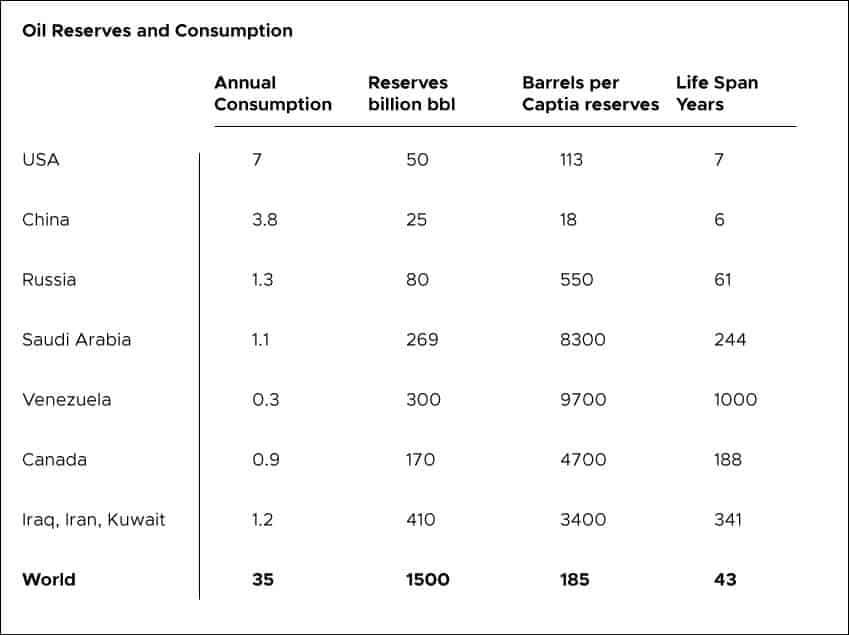Oil Supply
Our last newsletter showed the enviable energy circumstances in which Canada finds itself. However, for the world as a whole, and the USA in particular, the outlook is far less bright. Here we are looking solely at the supplies of oil, not the impact on climate. Despite limited world supplies, humanity clearly has more than enough carbon rope with which to hang itself.
Whatever supply advantage Canada may have over most countries, it is probable that Canadians will pay world global prices for energy and that we will begin to be subject to world environmental standards.
Consumption of Oil
Before humans began to extract oil from the ground in the late 1800’s there may have been between 2.5 and 3.5 trillion barrels globally. We have gone through slightly over half of it with about 1.5 trillion barrels remaining. Although we are always discovering new oil deposits, we are using it faster than we discover it so oil stocks are declining. Output appears to be dropping from the Bakken Shale Oil Basin (North Dakota) which was held out as the poster boy for the fantasy of American energy independence; “Saudi America”. But now the telltale signs of increasing gas-oil ratios and water cuts indicate that even more drilling will soon not be enough to forestall falling output. The US imports half its oil now and will never again be a net exporter.
In the near term, American oil production may increase and thereby keep oil prices low but the relatively low reserves of tight oil and their high cost of production will ensure that oil prices will rise in the not too distant future.

While Supplies Last
Life span by country means the oil they are consuming, not the total amount of oil they produce. Exports and imports are not considered. The USA imports half of its oil consumption which will effectively double the lifespan of its reserves. Saudi Arabia produces 3.9 billion barrels of oil annually, exporting 3 times what it consumes internally. Assuming this level of export continues, the lifespan of its reserves would be 69 years.
From the above table, it is clear that the largest consumers will have to rely increasingly heavily on imported oil. There are fewer and fewer net oil exporters. The USA ceased to be a net oil exporter in the late 1930s. Indonesia became a net importer in 2003, the UK in 2005 and Egypt in 2010. Given dramatically increasing domestic population growth and consumption, some forecasts have Saudi Arabia ceasing its exports by 2035.
The real cost of oil will increase as the proportion of conventional “easy” oil declines and the proportion of fracked, deep water or other non-conventional and more expensive oil increases. As it takes more energy to access the smaller and more difficult oil deposits, the EROI http://sustainablesociety.com/current-issues/243-energy-realities-1-how-energy-is-measured-eroi
Some oil consumption forecasts are based on extrapolations of past consumption rather that the oil that is in the ground. Some forecasts see rising prices and restrictions of carbon emissions reducing oil demand. However, there are several unshakable facts regarding oil:
Oil is irreplaceable for several sectors critical to our society:
Our Needs
- Agriculture
- Air travel
- Heavy transport
- Mining
- Mineral processing
- Military
– Oil supplies are finite
– Oil resources are declining in quality.
– We have already picked the low hanging fruit.
– The largest oil consumers have very small reserves.

The Clock is Ticking
Assuming oil consumption does not increase, our major reserves will be largely exhausted within 50 years. That means the conversion to renewable energy must be largely complete by then. The lead time required to shift our societies off fossil fuels is at least two generations. If programs to replace fossil fuels with renewables aren’t rapidly put in place, we will have insufficient energy to power our societies and this will have very predictable consequences.
An obvious start: – World supplies will not support the current discretionary use of oil for personal transport for many more decades. Example: 50% of US oil consumption is automotive gasoline.
The Age of Oil, which began around the end of WW 1, will not last more than 150 years – a blip on the human civilization time scale. Currently the world gets 33 % of its energy from oil and 2% from solar and wind. By the end of this century, we will have to be using less energy and all of the energy we do use will have to come from renewable sources. We need to plan for as long an overlap as possible so we can wean slowly off fossil fuels and thereby extend the length of time they will be available to us.
In order to make this transition as peaceful as possible, we need to pursue policies of conservation, consumption reduction and population stabilization along with the rapid buildup of renewable energy generating capacity.
For more on energy, please see: http://sustainablesociety.com/economy/energy-the-foundation
Global Energy Sources 2015
- Oil – 33%
- Coal -29%
- Natural Gas -24%
- Fossil Fuel Today -86%
- Hydro -7%
- Nuclear -5%
- Wind -1.5%
- Solar -0.5%
Sources producing electrical energy should be counted as 2 or 3 times their energy content when being compared to fossil fuel sources because fossil fuels are burned in generators with an efficiency rate between 30% and 50%.

